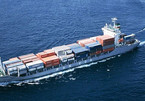 |
Viet Nam’s ports and shipping industry is more than sufficient to meet the country’s demand in import-export activities.
That is the response from the Vietnam National Shipping Lines (Vinalines) to a Bloomberg report claiming container shipping may need to grow at almost twice the pace of the last decade, which was reported at 10-12 per cent annually, to keep up with new, surging demand.
Bloomberg also claimed the country is facing a US$4 billion shortfall in developing its ports with no major projects nearing completion in the near future. Overcoming such an issue can prove to be a daunting task as the cases of early developers such as Japan and Korea have shown.
A high-ranking Vinalines official told the Vietnam News Agency the inauguration of deepwater port Lach Huyen in northern port Hai Phong City has significantly increased northern region’s shipping capacity. In the southern region, port complex Cai Mep-Thi Vai in Ba Ria-Vung Tau Province is and will be able to meet with the country’s rising demand in years to come.
“Some 18 million TEU of goods - twenty-foot equivalent unit for the capacity of container ships and container terminals - passed through Vietnamese ports every year,” said the Vinalines official.
“We anticipated this figure to reach 30-40 million in 2030. By that time, the country must have a number of additional ports built in both the northern and the southern regions.”
The Vietnamese fleet which comprises 39 ships, however, only accounted for 1.2-1.3 million TEU or just over 7 per cent. Establishing new shipping lines is both extremely difficult and expensive and usually requires both extensive knowledge and financial resources, requirements that can only be met by a handful of large shipping companies.
“In order to develop our own lines and to give domestic companies incentives to invest in growing their fleets, the country must come up with a vision for the shipping industry and support policies now,” said the official.
In addition, Vietnamese shipping companies must work to improve technical capacity and join forces with alliances in the global shipping industry.
According to the Vietnam Maritime Administration, the country has more than 1,500 ships with a total capacity of 7.8 billion tonnes, ranking 4th in ASEAN and 30th in the global fleet ranking. With an average age of 15.6 years old, the Vietnamese fleet has seen rapid growth in recent years from 19 ships in 2013 to 39 ships this year.
The fleet has carried more than 81 million tonnes of goods this year, a 16 per cent increase year-on-year, meeting the demand of domestic goods transport. So far its international lines are mostly to ports in China, Japan, Korea and ASEAN countries due to modest size and limited financial capacity.
There are some 281 ports operating across the country with a total capacity of 550 million tonnes per year. Major ports in key logistics region including Hai Phong City, Ba Ria-Vung Tau and HCM City have seen a significant upgrade in infrastructure to be able to receive ships with up to 30,000 DWT (Deadweight tonnage). At the same time, central region’s ports in Da Nang and Cam Ranh have seen fast-growth in recent years, according to a report on logistics by the administration.
The report, however, pointed out a number of shortcomings and limitations that have been hindering growth. As of now, Hai Phong Port is the only one that has been connected to the national railway. Poor infrastructure on both national road and waterway system has resulted in time wasted and increased logistics cost for shipping companies. — VNS

Sea shipping is flourishing in Vietnam
It is expected that the volume of goods to go through Vietnam’s ports will grow by 12-16 percent annually, and by 2030, it will be 1.5-2 times higher than now.
 Vietnam’s ports and shipping industry is more than sufficient to meet the country’s demand in import-export activities." itemprop="description" />
Vietnam’s ports and shipping industry is more than sufficient to meet the country’s demand in import-export activities." itemprop="description" />